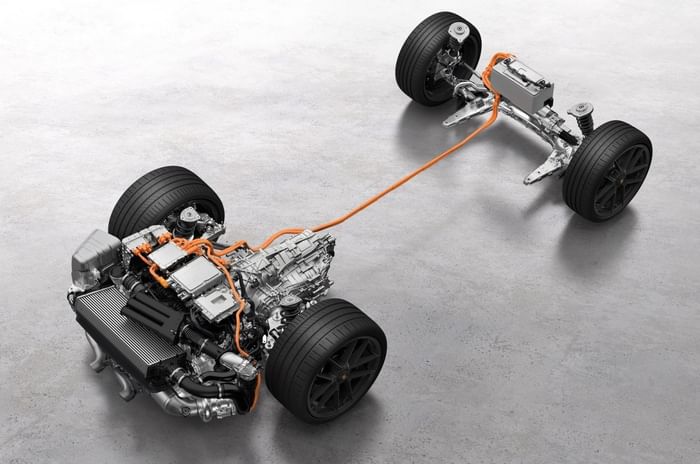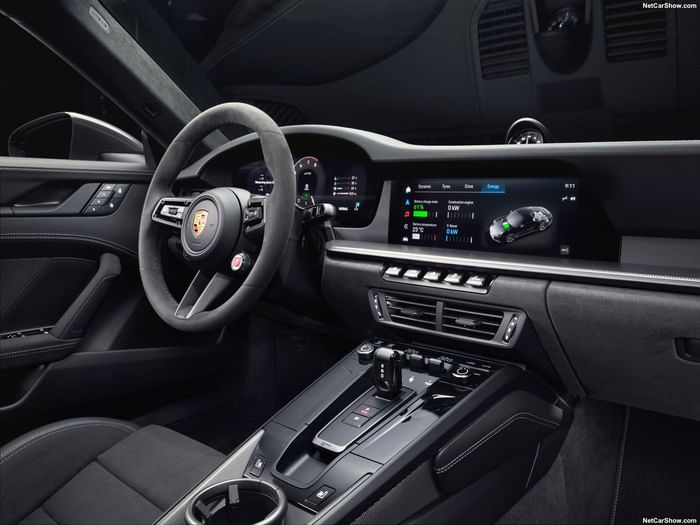Porsche has taken the wraps off its first street-legal hybrid 911 in the form of the 911 Carrera GTS. The hybridisation comes as part of the mid-cycle facelift for the seventh-gen 911, which also brings aero and design changes outside, more equipment, and a fresh interior.
- 911 Carrera GTS gets 541hp from 3.6-litre boxer engine and e-motor
- It is 8.6 seconds quicker around the Nurburgring than its predecessor
- Drag co-efficient reduced from 0.32 to 0.27
Porsche 911 hybrid powertrain details
Naturally, the new T-Hybrid petrol-electric system is the headline addition. The set-up features an all-new turbocharged 3.6-litre six-cylinder boxer engine, a gearbox-mounted electric motor and a compact liquid-cooled lithium-ion battery. Together, they provide the restyled rear-wheel-drive 911 Carrera GTS – which sits beneath the hardcore Turbo and GT3 and will be the first model to receive the drivetrain – with 541hp and up to 610Nm. Those outputs represent increases of 60hp and 40Nm over the previous model, which used a twin-turbo 3.0-litre six-cylinder.
Porsche claims a 0.4sec reduction in the 0-100kph time, at 3.0sec. It also quotes 0-160kph of 6.8sec (0.9sec quicker than before) and 0-200kph in 10.5sec (1.1sec quicker), along with an incremental increase in top speed to 312kph.

The improvements come despite a 50kg rise in kerb weight for the hybridised GTS, at 1595kg. Some 27kg of that is contributed by the battery, but because it sits up front, it is claimed to subtly improve the weight distribution of the new 911, giving a ratio of roughly 37:63 front to rear.
The performance-enhancing potential of this hybrid drivetrain is reflected in the new GTS’s official Nurburgring lap time, which is 8.7sec quicker than that of its predecessor, at 7min 16.93sec. Notably, that time is also roughly in line with the 718 Cayman GT4 RS and only four seconds behind the 918 Spyder.
T-Hybrid stands for Turbo Hybrid. Key among its developments is the adoption of a new BorgWarner turbocharger featuring an energy recuperation system that operates through the capture of hot exhaust gases. Similar to that employed on the 2.0-litre V4 petrol-electric hybrid drivetrain used by the 919 racer, it is capable of harvesting up to 11kW of kinetic electricity.

Together with the electric motor’s brake regen, this has allowed Porsche to engineer the T-Hybrid system with a compact 1.9kWh battery and without the need for external charging. The new single turbo replaces the twin exhaust-driven units fitted to the existing 3.0-litre engine, which will continue to be offered in certain 911 models. Porsche says the introduction of an electric compressor increases the acceleration of the exhaust gas through the turbo, leading to a faster and more linear build-up of boost pressure over a wider range of revs for added response and acceleration.
On its own, the new flat-six develops 485hp for a specific output of 135hp per litre, along with 570Nm of torque. The ZF disc-shaped electric motor is integrated within the front section of the standard 8-speed dual-clutch gearbox, generating 54hp and 150Nm at up to 7,500rpm. Together, the two power sources deliver peak power at 6,500rpm and 610Nm of torque on an impressively flat and extended range between 1,950rpm and 6,000rpm.
The packaging of the 400V lithium-ion battery and a pulse inverter used to power the electric motor within the front of the 911 has led to a 6-litre reduction in the size of the fuel tank, at 84 litres. The smaller 12V lithium-ion battery, meanwhile, has been relocated to a position underneath the rear seat.
The new Carrera GTS is being launched in rear-driven form but Porsche confirms the T-Hybrid system is also compatible with four-wheel drive, suggesting future incarnations of the 911 Turbo and Carrera 4 will benefit from the new drivetrain technology.
Porsche 911 facelift: what else is new?
Porsche has significantly improved the aerodynamic efficiency of the 911 with new active front air ducts on each side, which have louvres that open and close depending on the cooling demands of the radiators and brakes. The lower part of the facelifted 911’s front bumper is now occupied by radar and ultrasonic sensors, with the indicator functions now incorporated within the standard LED matrix headlight clusters. At the rear, the 911 adopts newly designed OLED tail-lights, a revised spoiler and reworked diffuser.

With an optional aero kit, the new 911 GTS is claimed to provide a big reduction in lift, developing 10kg of downforce at 312kph, rather than the 30kg of lift generated by the standard model. In combination with new aerodynamically optimised wheels, the drag coefficient has been reduced from the previous 0.32 to 0.27 – a new record for the 911.
The interior has been less obviously overhauled, but the analogue tachometer has been swapped out to make the driver display all-digital, and there are new hybrid-specific displays for the touchscreen. For now, there's no word on when Porsche will bring the 911 facelift to India.
Also see:
Porsche Macan EV review: The best handling electric SUV?
New Porsche Panamera India walkaround video
New Porsche Cayenne GTS priced at Rs 2 crore













Comments
Member Login
Personal Details
No comments yet. Be the first to comment.